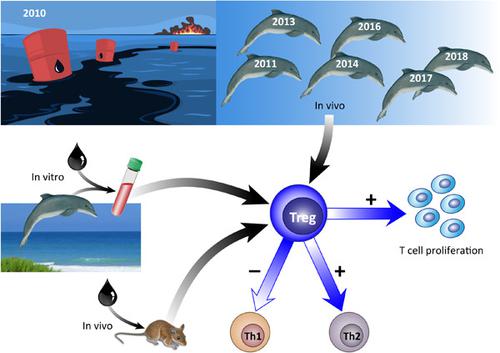当前位置:
X-MOL 学术
›
Environ. Toxicol. Chem.
›
论文详情
Our official English website, www.x-mol.net, welcomes your feedback! (Note: you will need to create a separate account there.)
Long‐Term Immunological Alterations in Bottlenose Dolphin a Decade after the Deepwater Horizon Oil Spill in the Northern Gulf of Mexico: Potential for Multigenerational Effects
Environmental Toxicology and Chemistry ( IF 4.1 ) Pub Date : 2021-02-17 , DOI: 10.1002/etc.4980 Sylvain De Guise 1, 2 , Milton Levin 1 , Lindsay Jasperse 1 , Jean Herrman 3 , Randall S Wells 4 , Teresa Rowles 5 , Lori Schwacke 6
Environmental Toxicology and Chemistry ( IF 4.1 ) Pub Date : 2021-02-17 , DOI: 10.1002/etc.4980 Sylvain De Guise 1, 2 , Milton Levin 1 , Lindsay Jasperse 1 , Jean Herrman 3 , Randall S Wells 4 , Teresa Rowles 5 , Lori Schwacke 6
Affiliation

|
Health assessments were conducted on bottlenose dolphins in Barataria Bay, Louisiana, USA, during 2011 to 2018, to assess potential health effects following the Deepwater Horizon oil spill, compared to the unoiled Sarasota Bay, Florida, USA, reference dolphin population. We previously reported significant increases in T‐lymphocyte proliferation, as well as lower T helper 1 (Th1) cytokines, higher Th2 cytokine IL‐4, and lower T regulatory (Treg) cytokine IL‐10 in Barataria Bay in 2011 compared to Sarasota Bay, consistent with Deepwater Horizon oil exposure. Although values between 2013 and 2016 were more similar to those observed in Sarasota Bay, T‐cell proliferation was again elevated and cytokine balance tilted toward Th2 in Barataria Bay during 2017–2018. In 2018, Barataria Bay dolphins had significantly more circulating Treg cells than Sarasota Bay dolphins. Mice experimentally exposed to oil also had significantly increased T‐lymphocyte proliferation and circulating Treg cell number, including effects in their unexposed progeny. In vitro stimulation resulted in greater Th2 responsiveness in Barataria Bay compared to Sarasota Bay dolphins, and in vitro oil exposure of Sarasota Bay dolphin cells also resulted in enhanced Th2 responsiveness. Evidence points to Treg cells as a potential target for the immunomodulatory effects of oil exposure. The immunological trends observed in Barataria Bay appeared exaggerated in dolphins born after the spill, suggesting the possibility of continued oil exposure or multigenerational health consequences of exposure to oil, as observed in mice. Environ Toxicol Chem 2021;40:1308–1321. © 2021 SETAC
中文翻译:

墨西哥湾北部深水地平线石油泄漏十年后,宽吻海豚的长期免疫学变化:多代影响的潜力
2011 年至 2018 年期间,对美国路易斯安那州巴拉塔里亚湾的宽吻海豚进行了健康评估,以评估深水地平线漏油事件后的潜在健康影响,并与美国佛罗里达州萨拉索塔湾未上油的参考海豚种群进行比较。我们之前报道过,与萨拉索塔湾相比,2011 年巴拉塔里亚湾的 T 淋巴细胞增殖显着增加,以及较低的 T 辅助 1 (Th1) 细胞因子、较高的 Th2 细胞因子 IL-4 和较低的 T 调节 (Treg) 细胞因子 IL-10 , 与深水地平线一致油暴露。尽管 2013 年和 2016 年之间的值与在萨拉索塔湾观察到的值更相似,但在 2017 年至 2018 年期间,巴拉塔里亚湾的 T 细胞增殖再次升高,细胞因子平衡向 Th2 倾斜。2018 年,巴拉塔里亚湾海豚的循环 Treg 细胞明显多于萨拉索塔湾海豚。实验性暴露于油的小鼠也显着增加了 T 淋巴细胞增殖和循环 Treg 细胞数量,包括对其未暴露后代的影响。与萨拉索塔湾海豚相比,体外刺激导致巴拉塔里亚湾的 Th2 反应性更强,萨拉索塔湾海豚细胞的体外油暴露也导致 Th2 反应性增强。有证据表明,Treg 细胞是油暴露免疫调节作用的潜在靶标。环境毒理学化学2021;40:1308-1321。© 2021 SETAC
更新日期:2021-04-23
中文翻译:

墨西哥湾北部深水地平线石油泄漏十年后,宽吻海豚的长期免疫学变化:多代影响的潜力
2011 年至 2018 年期间,对美国路易斯安那州巴拉塔里亚湾的宽吻海豚进行了健康评估,以评估深水地平线漏油事件后的潜在健康影响,并与美国佛罗里达州萨拉索塔湾未上油的参考海豚种群进行比较。我们之前报道过,与萨拉索塔湾相比,2011 年巴拉塔里亚湾的 T 淋巴细胞增殖显着增加,以及较低的 T 辅助 1 (Th1) 细胞因子、较高的 Th2 细胞因子 IL-4 和较低的 T 调节 (Treg) 细胞因子 IL-10 , 与深水地平线一致油暴露。尽管 2013 年和 2016 年之间的值与在萨拉索塔湾观察到的值更相似,但在 2017 年至 2018 年期间,巴拉塔里亚湾的 T 细胞增殖再次升高,细胞因子平衡向 Th2 倾斜。2018 年,巴拉塔里亚湾海豚的循环 Treg 细胞明显多于萨拉索塔湾海豚。实验性暴露于油的小鼠也显着增加了 T 淋巴细胞增殖和循环 Treg 细胞数量,包括对其未暴露后代的影响。与萨拉索塔湾海豚相比,体外刺激导致巴拉塔里亚湾的 Th2 反应性更强,萨拉索塔湾海豚细胞的体外油暴露也导致 Th2 反应性增强。有证据表明,Treg 细胞是油暴露免疫调节作用的潜在靶标。环境毒理学化学2021;40:1308-1321。© 2021 SETAC



























 京公网安备 11010802027423号
京公网安备 11010802027423号